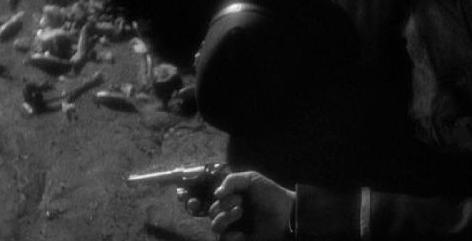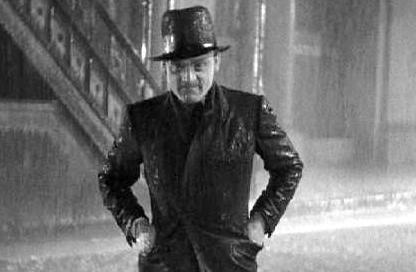 From left: James Cagney (Tom Powers), Jean Harlow (Gwen Allen), Edward Woods (Matt Doyle), and Joan Blondell (Mamie).
From left: James Cagney (Tom Powers), Jean Harlow (Gwen Allen), Edward Woods (Matt Doyle), and Joan Blondell (Mamie). Tom Powers. Today, the gangster archetype is typified on a scale of comparison to performances by either Robert De Niro or Al Pacino. Whether set up against the white hot adrenaline of Pacino, or built up around the brooding intensity of De Niro, modern gangster films have become a classic staple of American cinema second only to the western.
Scorcese and Coppola merit the bulk of the credit for their masterful weavings of, respectively, the Goodfellas and Godfather sagas. Yet a string of directors have helmed such recent cult gangster films as Miller's Crossing, King of New York, Carlito's Way, Donnie Brasco, Romeo is Bleeding, Hoodlum, Mobsters, and Road to Perdition.
But prior to all of this, there was Tom Powers. The protagonist of The Public Enemy was an ambitious, cunningly intelligent, borderline misanthropic mobster. It was a role no different from the gangsters in other pre-code era films, such as Scarface or Little Caesar, except for one aspect - James Cagney.
Cagney's energetic performance in The Public Enemy decisively established his career and gave birth to scores of mob-related films, many including Cagney. Tight scripting and top gear acting (with a few exceptions, Jean Harlow is a significant low point in that department) ensure a never dull picture, and the cinematography is astonishingly picturesque at times.
Watch the montage of city life at the beginning and marvel at the rather long tracking shot that introduces the two main characters as children. Another early scene involves Powers, as a teenager, getting himself into trouble with his strict, diciplinarian father. The father slowly walks to the kitchen to retrieve his lash as his mother looks on sympathetically.
The camera remains stationary as the father, ever so slowly, strides into Powers room to punish him. The scene is shot with such delicate care in regards to the subject matter that it is every bit the equal to modern portrayals of castigation.
The attention to detail, curiously adept for such an early film, is breathtaking. A later scene has a camera hidden in the ground so that a gangster's car drives over it ominously. When a police officer is killed during Powers first big heist, the film depicts his death by displaying a hand clutching a revolver - smoke still subtly trailing from the barrel.
I could expound on the amount of deftly shot scenes endlessly. Perhaps most notably, the infamous grapefruit scene became so iconic that it's still parodied to this day.
And the chilling climax, in which Powers seeks revenge for the death of his best friend, remains one of the preeminent symbols of early pre-code cinematic violence.
His gang weakened by the accidental death of its primary enforcer, Powers finds himself outgunned and essentially aloof. Paddy, the gang's leader, strives to protect what's left of his outfit by sequestering them in an apartment, replete with a mistress to take care of them.
After barely a day, Powers grows restless (and incensed at the mistress who seduced him in a drunken state) and storms out. Matt Doyle, ever Powers intrepid companion, accompanies him.
Not surprisingly, rival gang members are lying in wait and immediately open fire as they depart. Doyle is struck and nearly instantly killed, while Powers is able to seek cover around a corner. Beside himself with fury, Powers plots a devious retribution.
Alone in the rain he stands silently, watching the rival gang's automobiles arrive at a popular hangout for the gang. One by one they scurry inside as Powers glares at them. Though an malicious grin escapes his lips, it's clearly evident his rage is rapidly reaching a boiling point. That's when Powers shoves both hands in his coat pockets and marches inside the building.
Powers staggers down the street a bit before collapsing in the gutter, torrential rain descending around him, only managing a weak "I ain't so tough" before losing consciousness. The screen fades to black, and only then is the tension dissolved.
What makes this series of events so remarkable is that no actual violence is seen. The entire episode takes place within the recesses of your own mind, and that can often be more terrifying that any cinematic sequence could ever be.
It's brilliantly executed and boldly shot with such a detached sense of realism that you feel as if you're standing right there on the corner next to Powers. . .and still there as he commits murder.
The Public Enemy, in the humble opinion of Hurry Home Dark Cloud, is the purest exemplification of the gangster film. In the years since its release, all others have served as naught but pallid facsimiles.




No comments:
Post a Comment